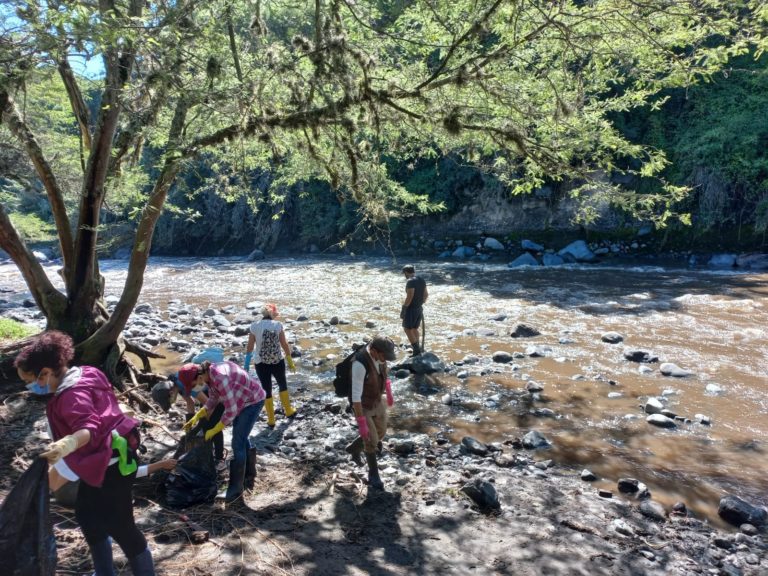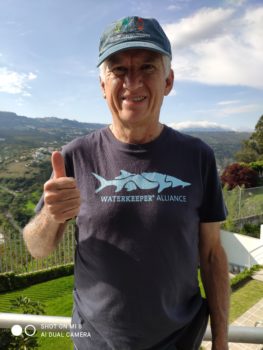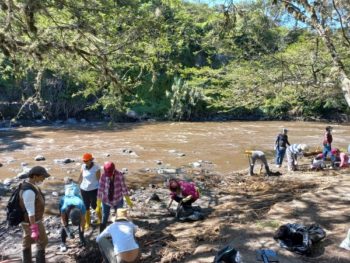Promoting Life in the Creeks of Ecuador’s Guayllabamba River
By: Guayllabamba Waterkeeper

By Patricio Chambers, Guayllabamba Waterkeeper
The creeks of the Guayllabamba River in Ecuador constitute its “veins” through which small permanent or temporary streams feed into a main body of water.
One of the quintessential elements of the hydrographic basins of the Sierra are the creeks and their surroundings (“quebradas” in Spanish); this word means “narrow passage between mountains” and is etymologically related to “crepare” (Latin) which refers to making a loud noise, bursting, cracking.
For the ancestral inhabitants of Quito, Ecuador, they were important locations where myths, customs, and traditions were generated, since they were spaces with an enormous diversity of flora and fauna. For the people, they were places of adventure and recreation.
Unfortunately, over time, the streams lost their ecological quality and many of them became sources of environmental contamination, also generating public health problems.
According to a 2013 study from the University of California, Berkeley, “The municipal authorities of Quito considered the streams an obstacle to urban development. Thus, public policy promoted the filling of quebradas to build streets and parks. Many quebradas were filled with garbage and debris, and their flow was dominated by domestic and industrial sewage during the dry season. The air, soil, and water contamination reinforced the need to fill them. Quito’s streams gradually disappeared, and with them, the opportunities of the citizens to keep and enjoy their natural surroundings.”

For this reason, and several years ago, the Guayllabamba Waterkeeper Association undertook a “Creeks Restoration Program” in the upper basin of the Guayllabamba River.
This program aims to restore ideal habitat to the large number of species of flora and fauna in these spaces, surrounded by trees and shrubs that host multiple expressions of life. Most of which go unnoticed by passersby absorbed in their personal thoughts, unaware of the world full of birds, mammals, and insects around them.
These are true ecosystems through which, in many cases, small streams flow. Or in others, the streams are simply maintained as water channels in the rainy seasons, in which even small fish appear.
With due attention, these spaces become great places for recreation, since both their extension and their breadth allow people to take advantage of them, perhaps by camping around them and in certain cases, bathing in their waters and waterfalls.
When walking its trails, we find ourselves with a magnificent natural environment that leads us to discover what was pointed out by the philosopher Jorge A. Livraga, who affirms that the human being is neither the owner nor the slave of nature but part of it.
If, on the contrary, when the streams and their valleys are abandoned, the way will be opened for assailants to find the best shelter for their dens in the dense vegetation.
To avoid such consequences, as well as the deterioration of the habitat, our program works on two fundamental aspects:
The first is ecological restoration, which seeks to return the impacted ecosystem to its original state, in turn restoring the ability of these areas to self-sustain.

The second is working with riverside communities on protection plans for these areas, through training and involvement in actions such as reforestation with native plants of the area, thereby empowering those who live in areas surrounding the streams.
The most successful mechanism used by our organization is the community cooperative work called “mingas,” which has allowed us to fulfill important objectives through the integration of volunteers from friendly organizations, residents of neighboring localities, university students, citizen groups, etc.
To this is added the collaboration of technicians and local government agencies such as the Municipality of the Metropolitan District of Quito, Decentralized Autonomous Governments, and private companies aware of their social responsibility.
Unfortunately, due to the presence of COVID-19 worldwide, it was only at the end of November last year that it was possible to resume our field activities and together with other citizen organizations to carry out a “minga” to clean the San Pedro River, a tributary of the Guayllabamba, in Los Algarrobos Park sector (Cumbayá).
In any case, we are still attentive to the evolution of the pandemic to return as soon as possible to this wonderful task: to give life to the creeks of the upper Guayllabamba basin.
Support Guayllabamba Waterkeeper in this work by making your tax-deductible donation today.